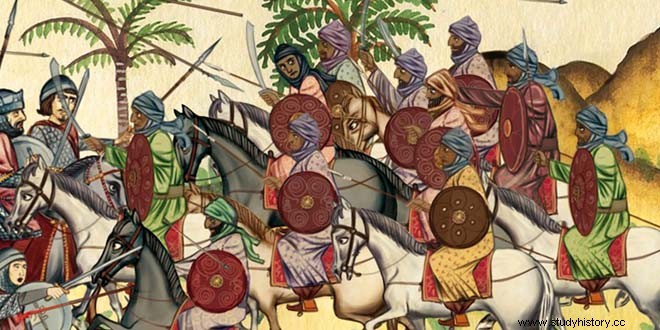Muslim society had a theocratic character, in that there was not the slightest separation between the religious and political spheres. In any case, during the stage of the independent Emirate of al-Andalus, he broke his ties with the caliphs of Baghdad in the political field , although they continued to recognize their spiritual superiority. But with the self-proclamation of Abderramán III as caliph, al-Andalus completely broke away from the ties that still united them with the Abbasid caliphs. The caliph was both temporal and spiritual head of the community . He presided over Friday prayers, judged ultimately, minted coins with his name on them, and led the army.
Political Structure
Next to the caliph was the hachib, butler of the palace or chamberlain, who was a kind of prime minister . The hachib was at the head of the royal house, while controlling the fundamental services of the court, the Chancellery and the Treasury. Below the hachib were the viziers, people who in al-Andalus held a lower position than in other Islamic countries . The number of viziers varied over time, reaching, in the time of Abderramán III, no less than sixteen.
Administration in al-Andalus
The main nuclei of the central administration were the Chancellery and the Treasury. The Foreign Ministry It was the office in charge of issuing official documents. The Hacienda collected the zacat or alms given by the Muslim faithful and the taxes collected from Mozarabs and Jews, as well as extraordinary income, a chapter that could include from the taxes paid by the Christian monarchs to the contributions that were requested from the people, on certain occasions, to finance the army. Everything seems to indicate that the income of the Andalusian Treasury grew extraordinarily in Caliphate times. From a judicial point of view, there were the qadis , people who required important religious knowledge as well as irreproachable moral conduct. The most important qadi was obviously the one from the city of Córdoba. The prestige enjoyed by the qadis of Cordoba was so high that one of them, Said al-Balluti, once reproached none other than Abderramán III himself.
Army
The army of al-Andalus was made up of soldiers recruited through levies as well as foreign mercenaries and volunteer fighters. The horsemen predominated over the infantry corps. The highest position was occupied, after the emir or the caliph, by the amir , kind of supreme general. Below him were the fallen , who led the expeditionary forces. It also had great importance in al-An-dalus, particularly from the time of Abderramán III, the navy. Important milestones in the seafaring activity of al-Andalus were Algeciras, Almería-Pechina, the main manufacturing area for warships, and Tortosa.

Coras
Al-Andalus as a whole was divided into a series of constituencies or coras . Most of the coras are known by the name of their main urban nucleus:Seville, Elvira (Granada), Algeciras, Jaén, Rayya (Málaga), Carmona, Écija, etc. For their part, the coras comprised a variable number of districts or iqlim . The number of coras increased over time. Let us remember, as an example, the foundation, in the year 931, following the conquest of Ceuta, of the "African cora". At the head of each cora was a governor or valí.
